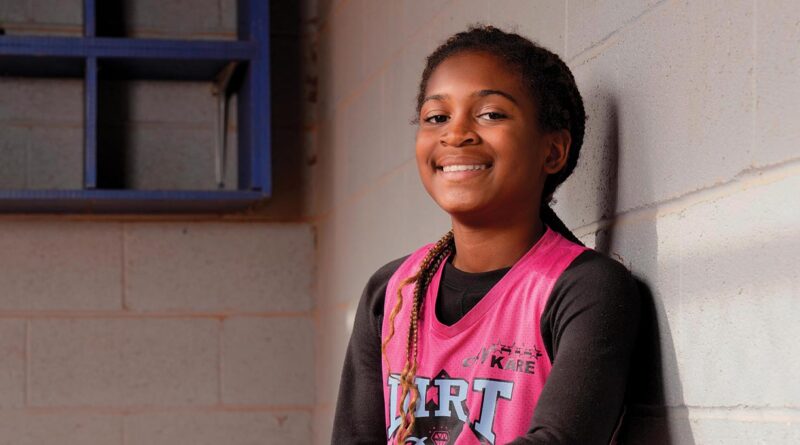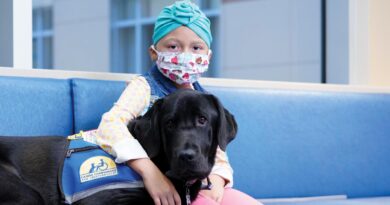Back in Action
Published on January 27th, 2021 by Christina Echegaray.
On March 3, 2020, shortly after 7 p.m., Ashley Cash got the phone call no parent ever wants to get. There had been an accident.
Her three daughters, Kanaiah Taylor, 15, Zakaiah Taylor, 12, and Carliyah Taylor, then 9, had been passengers in a motor vehicle accident while in their grandparents’ car. They were en route from Lewisburg, Tennessee, to nearby Shelbyville for travel team basketball practice when another car swerved into their lane, causing a wreck.
Kanaiah, Cash’s oldest daughter, called her mom. “She told me, ‘Mama, there’s been a wreck,’” Cash said, adding that Kanaiah wasn’t sure Carliyah was alive. Cash drove to the crash site, arriving nearly the same time as emergency medical personnel. The other girls were in shock and scraped up. Their grandfather had been able to get out of the car. Their grandmother had to be extricated from the car by firefighters and had several injuries, requiring hospitalization.
Unconscious with injuries unknown following the crash, Carliyah was brought by LifeFlight helicopter to Monroe Carell Jr. Children’s Hospital at Vanderbilt in Nashville.
Children’s Hospital is the only comprehensive regional pediatric center within a 150-mile radius to be verified by American College of Surgeons, the country’s leading surgical care organization, as a Level 1 pediatric trauma center. The certification recognizes the hospital’s commitment to provide the highest level of care for injured pediatric patients from Alabama to Kentucky and throughout Tennessee.
Only 63 children’s hospitals in the country have ACS Level 1 pediatric trauma center status, and Children’s Hospital is only one of two hospitals in Tennessee to earn the verification. Children’s Hospital is equipped to treat patients with a wide range of injuries resulting from incidents like all-terrain vehicle accidents, motor vehicle crashes, falls, gunshot wounds, and bicycle wrecks, among other events.
Also, as a larger comprehensive pediatric center, Children’s Hospital has the ability to fully evaluate and treat pediatric patients for their injuries and beyond, pulling in board-certified medical and surgical pediatric specialists from more than 30 specialties.
“Our trauma program has broad outreach, and we get children from all over Tennessee, into northern Alabama and southwest Kentucky. When children are brought to us, parents can be assured their children are coming to one of the top institutions in the country for trauma care and comprehensive pediatric care,” said Harold “Bo” Lovvorn III, MD, medical director of the Pediatric Trauma Program at Children’s Hospital and associate professor of Pediatric Surgery. “We look over these children in every detail. We have the expertise as an institution to take care of a child from the physicians, surgeons, nurses, radiologists, anesthesiologists, and beyond.”
Children’s Hospital’s Pediatric Trauma service admits more than 1,200 pediatric trauma patients each year. The collaboration across multiple disciplines, care units and behind-the-scenes staff helps patients get the quality, compassionate care they need.
That cross-section of expertise also helps in unique cases like Carliyah’s. Her trauma injuries didn’t tell the full story of what was happening inside her body.
When Carliyah, who was intubated at the scene, arrived at Children’s Hospital, Lovvorn said, both her lungs were bruised, consistent with trauma, and she had a swollen eye and abrasions on her face. She had a concussion from hitting her head during the accident. Evaluations revealed she should recover fully from the accident.
Her blood work, however, showed that she had elevated lipase levels, an enzyme in the body related to the function of the pancreas. A CT scan of her abdomen didn’t show any trauma injury. But it revealed something that the doctors and radiologist never expected to find — a complex choledochal cyst in her bile duct, completely unrelated to the accident.
Choledochal cysts are congenital — present from birth — and are a developmental abnormality of the bile duct. They occur in about one in every 100,000 people. While they are congenital, most are never detected until later in adulthood, when there is increased risk for pancreatitis and even bile duct cancer.
“Here this family has just been through a major accident — one that could have been really tragic — and you’re telling them, your daughter is going to recover, but she has another major problem we have to sit down and talk about,” Lovvorn said.
“(These cysts) can cause a lot of issues — chronic pancreatitis, poor bile flow into the intestine, bile duct infection, chronic abdominal pain. Removing the cyst can resolve the chronic pancreatitis, help with better digestion, reduce risk of colon dryness or bile duct infection. Removing it later in life increases that chance for bile duct cancer. About 40% of adults with these will develop cancer.”
Carliyah’s cyst was about 22 millimeters in size, when that area of the bile duct known as the biliary tree should be about 2-3 millimeters in size.
When Cash found out about Carliyah’s cyst, she said it made sense. Carliyah, an active athlete who plays travel softball and basketball, has always had a healthy appetite. But many times, she has complained of abdominal pain.
“He told me they found something else not related to the wreck — a cyst. He told me this could cause problems for her own the road, and when she’s 40 or 50 years old, it could cause cancer,” Cash said. “I just thought she was eating so much. I had told her ‘you’re complaining your stomach hurts because you’re eating so much.’”
Just as Cash was told Carliyah had a cyst, the COVID-19 pandemic hit. Additionally, all non-emergent surgeries were put on hold. Lovvorn wanted to remove the cyst but knew the procedure would have to wait.
After a few days in the hospital following the accident, Carliyah was sent home.
She returned to Children’s Hospital in May to have an MRI to give Lovvorn a better sense of the size and scope of the choledochal cyst. Remaining “visits” were virtual via telehealth because of the pandemic until surgery could be performed.
At the end of August, Lovvorn performed a four-hour surgery to carefully separate the cyst, dissect part of the liver and reconnect the intestine.
“I’ve done a lot of these operations before, and the typical stay is about four or five days. Carliyah went home in two days,” Lovvorn said. “Then I see her a couple weeks later, and she was totally fine — you wouldn’t have known anything was wrong with her. She is one Tennessee-tough kid.”
In October 2020, a little more than a month after her surgery, Carliyah, now 10, was back on the baseball field, playing outfield and second base for her team, the Dirt Divas. In one weekend, she hit three home runs.
“This child is a go getter. She is loving all the time — just full of life, full of energy and all turning flips,” Cash said. “Nothing keeps that child down.”
— by Christina Echegaray
Hope – Winter 2021


